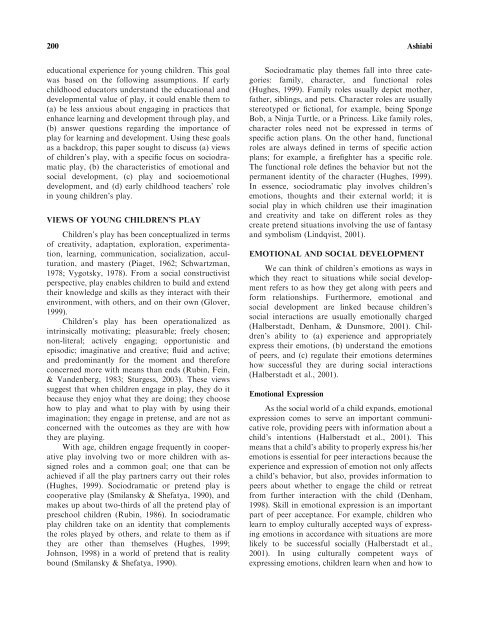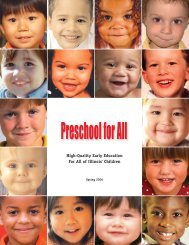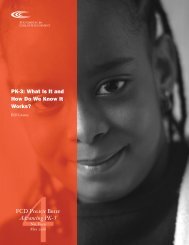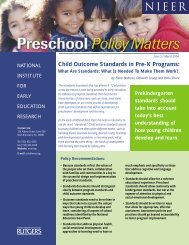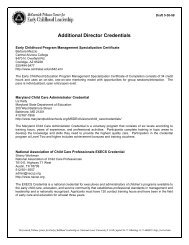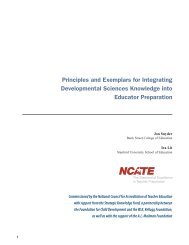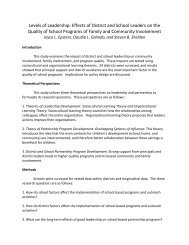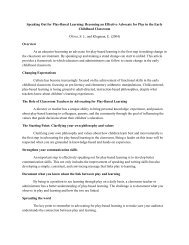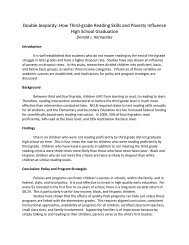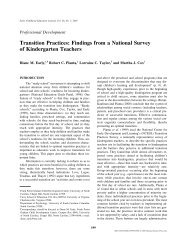Play in the Preschool Classroom - Leadership to INtegrate the Early ...
Play in the Preschool Classroom - Leadership to INtegrate the Early ...
Play in the Preschool Classroom - Leadership to INtegrate the Early ...
Create successful ePaper yourself
Turn your PDF publications into a flip-book with our unique Google optimized e-Paper software.
200 Ashiabi<br />
educational experience for young children. This goal<br />
was based on <strong>the</strong> follow<strong>in</strong>g assumptions. If early<br />
childhood educa<strong>to</strong>rs understand <strong>the</strong> educational and<br />
developmental value of play, it could enable <strong>the</strong>m <strong>to</strong><br />
(a) be less anxious about engag<strong>in</strong>g <strong>in</strong> practices that<br />
enhance learn<strong>in</strong>g and development through play, and<br />
(b) answer questions regard<strong>in</strong>g <strong>the</strong> importance of<br />
play for learn<strong>in</strong>g and development. Us<strong>in</strong>g <strong>the</strong>se goals<br />
as a backdrop, this paper sought <strong>to</strong> discuss (a) views<br />
of children’s play, with a specific focus on sociodramatic<br />
play, (b) <strong>the</strong> characteristics of emotional and<br />
social development, (c) play and socioemotional<br />
development, and (d) early childhood teachers’ role<br />
<strong>in</strong> young children’s play.<br />
VIEWS OF YOUNG CHILDREN’S PLAY<br />
Children’s play has been conceptualized <strong>in</strong> terms<br />
of creativity, adaptation, exploration, experimentation,<br />
learn<strong>in</strong>g, communication, socialization, acculturation,<br />
and mastery (Piaget, 1962; Schwartzman,<br />
1978; Vygotsky, 1978). From a social constructivist<br />
perspective, play enables children <strong>to</strong> build and extend<br />
<strong>the</strong>ir knowledge and skills as <strong>the</strong>y <strong>in</strong>teract with <strong>the</strong>ir<br />
environment, with o<strong>the</strong>rs, and on <strong>the</strong>ir own (Glover,<br />
1999).<br />
Children’s play has been operationalized as<br />
<strong>in</strong>tr<strong>in</strong>sically motivat<strong>in</strong>g; pleasurable; freely chosen;<br />
non-literal; actively engag<strong>in</strong>g; opportunistic and<br />
episodic; imag<strong>in</strong>ative and creative; fluid and active;<br />
and predom<strong>in</strong>antly for <strong>the</strong> moment and <strong>the</strong>refore<br />
concerned more with means than ends (Rub<strong>in</strong>, Fe<strong>in</strong>,<br />
& Vandenberg, 1983; Sturgess, 2003). These views<br />
suggest that when children engage <strong>in</strong> play, <strong>the</strong>y do it<br />
because <strong>the</strong>y enjoy what <strong>the</strong>y are do<strong>in</strong>g; <strong>the</strong>y choose<br />
how <strong>to</strong> play and what <strong>to</strong> play with by us<strong>in</strong>g <strong>the</strong>ir<br />
imag<strong>in</strong>ation; <strong>the</strong>y engage <strong>in</strong> pretense, and are not as<br />
concerned with <strong>the</strong> outcomes as <strong>the</strong>y are with how<br />
<strong>the</strong>y are play<strong>in</strong>g.<br />
With age, children engage frequently <strong>in</strong> cooperative<br />
play <strong>in</strong>volv<strong>in</strong>g two or more children with assigned<br />
roles and a common goal; one that can be<br />
achieved if all <strong>the</strong> play partners carry out <strong>the</strong>ir roles<br />
(Hughes, 1999). Sociodramatic or pretend play is<br />
cooperative play (Smilansky & Shefatya, 1990), and<br />
makes up about two-thirds of all <strong>the</strong> pretend play of<br />
preschool children (Rub<strong>in</strong>, 1986). In sociodramatic<br />
play children take on an identity that complements<br />
<strong>the</strong> roles played by o<strong>the</strong>rs, and relate <strong>to</strong> <strong>the</strong>m as if<br />
<strong>the</strong>y are o<strong>the</strong>r than <strong>the</strong>mselves (Hughes, 1999;<br />
Johnson, 1998) <strong>in</strong> a world of pretend that is reality<br />
bound (Smilansky & Shefatya, 1990).<br />
Sociodramatic play <strong>the</strong>mes fall <strong>in</strong><strong>to</strong> three categories:<br />
family, character, and functional roles<br />
(Hughes, 1999). Family roles usually depict mo<strong>the</strong>r,<br />
fa<strong>the</strong>r, sibl<strong>in</strong>gs, and pets. Character roles are usually<br />
stereotyped or fictional, for example, be<strong>in</strong>g Sponge<br />
Bob, a N<strong>in</strong>ja Turtle, or a Pr<strong>in</strong>cess. Like family roles,<br />
character roles need not be expressed <strong>in</strong> terms of<br />
specific action plans. On <strong>the</strong> o<strong>the</strong>r hand, functional<br />
roles are always def<strong>in</strong>ed <strong>in</strong> terms of specific action<br />
plans; for example, a firefighter has a specific role.<br />
The functional role def<strong>in</strong>es <strong>the</strong> behavior but not <strong>the</strong><br />
permanent identity of <strong>the</strong> character (Hughes, 1999).<br />
In essence, sociodramatic play <strong>in</strong>volves children’s<br />
emotions, thoughts and <strong>the</strong>ir external world; it is<br />
social play <strong>in</strong> which children use <strong>the</strong>ir imag<strong>in</strong>ation<br />
and creativity and take on different roles as <strong>the</strong>y<br />
create pretend situations <strong>in</strong>volv<strong>in</strong>g <strong>the</strong> use of fantasy<br />
and symbolism (L<strong>in</strong>dqvist, 2001).<br />
EMOTIONAL AND SOCIAL DEVELOPMENT<br />
We can th<strong>in</strong>k of children’s emotions as ways <strong>in</strong><br />
which <strong>the</strong>y react <strong>to</strong> situations while social development<br />
refers <strong>to</strong> as how <strong>the</strong>y get along with peers and<br />
form relationships. Fur<strong>the</strong>rmore, emotional and<br />
social development are l<strong>in</strong>ked because children’s<br />
social <strong>in</strong>teractions are usually emotionally charged<br />
(Halberstadt, Denham, & Dunsmore, 2001). Children’s<br />
ability <strong>to</strong> (a) experience and appropriately<br />
express <strong>the</strong>ir emotions, (b) understand <strong>the</strong> emotions<br />
of peers, and (c) regulate <strong>the</strong>ir emotions determ<strong>in</strong>es<br />
how successful <strong>the</strong>y are dur<strong>in</strong>g social <strong>in</strong>teractions<br />
(Halberstadt et al., 2001).<br />
Emotional Expression<br />
As <strong>the</strong> social world of a child expands, emotional<br />
expression comes <strong>to</strong> serve an important communicative<br />
role, provid<strong>in</strong>g peers with <strong>in</strong>formation about a<br />
child’s <strong>in</strong>tentions (Halberstadt et al., 2001). This<br />
means that a child’s ability <strong>to</strong> properly express his/her<br />
emotions is essential for peer <strong>in</strong>teractions because <strong>the</strong><br />
experience and expression of emotion not only affects<br />
a child’s behavior, but also, provides <strong>in</strong>formation <strong>to</strong><br />
peers about whe<strong>the</strong>r <strong>to</strong> engage <strong>the</strong> child or retreat<br />
from fur<strong>the</strong>r <strong>in</strong>teraction with <strong>the</strong> child (Denham,<br />
1998). Skill <strong>in</strong> emotional expression is an important<br />
part of peer acceptance. For example, children who<br />
learn <strong>to</strong> employ culturally accepted ways of express<strong>in</strong>g<br />
emotions <strong>in</strong> accordance with situations are more<br />
likely <strong>to</strong> be successful socially (Halberstadt et al.,<br />
2001). In us<strong>in</strong>g culturally competent ways of<br />
express<strong>in</strong>g emotions, children learn when and how <strong>to</strong>


